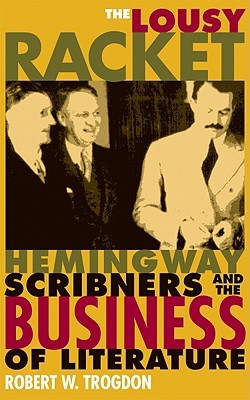 The Lousy Racket: Hemingway, Scribner's and the Business of Literature
The Lousy Racket: Hemingway, Scribner's and the Business of Literature
Robert W. Trogdon
The Kent State University Press
2007
307 pages
$30.00
While reading the first volume of Hemingway's letters published recently (they're up to volume IV now) I came across mention of Trogdon's 2007 book. Trogdon is one of the series editors, so it made sense to find this book slipped into the works cited, and I was intrigued to find out that it concentrates on Hemingway's relationship with his publisher and its chief representative, Maxwell Perkins, editor extraordinaire. A. Scott Berg discusses Perkins' role in curating the career of F. Scott Fitzgerald and Thomas Wolfe in Max Perkins: Editor of Genius, but spends surprisingly less time on his role with Hemingway. Trogdon rectifies that omission in this book, a thorough discussion of issues Hemingway faced with particular attention to sales and money concerns, as well as issues of censorship and potential lawsuits. Trogdon's sympathy lies with Perkins as editor and publisher rep, who became both cheerleader and hard-headed business realist as compared with Hemingway's often angry blusterer.
The first major issue came up with the book Scribner's took on after Hemingway's break with his first major publisher, Boni & Liveright, The Torrents of Spring. In a now famous publishing story, Hemingway used the unflattering portrait of Sherwood Anderson he wrote in Torrents to break his contract with Boni & Liveright, knowing they would not agree to publish something that satirized their leading light, which then gave him the opportunity to move to Scribner's, with whom he would spend the rest of his life.
"The most compelling reason for Hemingway's dissatisfaction with Boni & Liveright was the marketing of [his first book] In Our Time. Liveright was more interested in what Hemingway would do in the future than in his initial American publication. Short story collections typically sold badly, especially when they were the first books of unknown authors. Liveright appears to have treated the book as a lost cause right from the beginning, publishing it only to secure the talented author for the firm. Liveright ordered only 1,335 copies, indicating that a large sale was not expected." (19)
Trogdon's strength is in the numbers crunched. We learn not just that only 1,335 copies were printed, Liveright spent only $653.10 on advertising, and didn't feature the book until page 25 of its fall 1925 catalog. Trogdon's access to and analysis of the advertising budget, ad placements and catalog copy give us a much clearer picture of what really prompted Hemingway's desire to shift publishers: money.
Even so, the publisher switch didn't mean that Scribner's took a wild flyer on Hemingway and threw buckets of money at him. Trogdon reports only a $500 advance and 2,785 copies printed on Hemingway's first Scribner's book, The Torrents of Spring, with an ad budget of $796.54 in 35 venues. Not the numbers of something they expected a great deal of movement from. This seemed to create in Hemingway the bane of all publishers, the writer who constantly bitches about money.That would all change–or would it?–with Hemingway's first proper novel, The Sun Also Rises, the reason Scribner's wanted Hemingway to begin with.
Money and the pursuit of it remained a theme throughout Hemingway's time, a theme he returned to with increasing petulance and ferocity depending on how he felt at the time, given the ads he saw in the trades and general interest magazines, and how many copies of his books Scribner's printed. He remained convinced that the publisher didn't do enough to push his books of the 1930s, a time during which his popular and critical reception faded a bit from the high points of The Sun Also Rises and A Farewell to Arms, a downturn only cured by the 1940 blockbuster For Whom the Bell Tolls. Perkins at these times reassured Hemingway that the publisher remained firmly in his side, and that they were doing the best that they could, given the demands of the market and the times.
Other demands came to the fore as well, primary among them the issues of censorship and potential libel. Hemingway insisted, in his personal writing credo and in his business interests, that he never used a word without knowing it was the best word for the situation, and it quickly came to pass that his use of four-letter words commonly used would never work in the relatively staid confines of Scribners and the publishing world in general. As well, his habit of lifting real-world friends and sometimes enemies and placing them in his novels with barely-changed names and characteristics proved to be an issue.
Still, the emphasis this book places on the money trail during Hemingway's career at Scribner's: the ad budgets and placement, the contracts, the remunerative book club deal that put For Whom the Bell Tolls over the top in sales, all taken from Scribner's records and documents from the Hemingway collection, serve to remind us all of Hemingway's true perspective. First, the actual work mattered. Second, but nearly equally, the money mattered, regardless of critical or audience opinion. If you're interested in the often sobering business of literature–all dollar amounts are also listed in 2005 dollars–and Hemingway, you shouldn't overlook this book.





